Barcelona
Barcelona is Spain's second largest city, with a population of nearly two million people, and the capital of Catalonia. A major port on the northeastern Mediterranean coast of Spain, Barcelona has a wide variety of attractions that bring in tourists from around the globe. The many faces of Barcelona include the medieval Old Town, and the unique street grid resulting from 19th-century urban planning. The city has long sandy beaches and green parks on the hills, pretty much side-by-side. It is also famous for a number of prominent buildings, of which the most-known are by the architect Antonio Gaudi, including his Sagrada Família, which became Barcelona's symbol to many.
Founded more than 2,000 years ago as the ancient Roman town Barcino, Barcelona is as historic as it is modern, with a constant flow of projects changing the face of the city and long-standing penchant for design and innovation. Thanks to the wealth of attractions, a very well-developed accommodation base, a lively nightlife and a robust transportation system, Barcelona has become one of Europe's, and pretty much the world's, most popular tourist destinations.
Districts
| Ciutat Vella Barcelona's old town, including the medieval Barri Gòtic, La Rambla (Les Rambles), Raval, and El Born (also known as La Ribera) |
| Eixample Modernist quarter, central hub of the city, and the area to go to find Antoni Gaudí's work. |
| Gràcia Formerly an independent town, it joined the city in the 20th century. Narrow streets and a cosmopolitan and young atmosphere with not too many tourists |
| Sants-Montjuïc Plaça Espanya and Montjuïc have been the focus of several great fairs and exhibitions. They have left behind museums, monuments and festivals for travellers to explore. |
| Sant Martí More beaches along the coast, but generally fewer tourists and tourist attractions. |
| Inland Suburbs Mostly residential, but there are some sights if you want to explore. It includes Camp Nou, home of FC Barcelona; Tibidabo, the highest point in Barcelona; and more Gaudí architecture. |
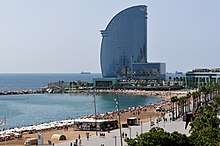
Understand
When to visit
| Barcelona | ||||||||||||||||||||||||||||||||||||||||||||||||||||||||||||
|---|---|---|---|---|---|---|---|---|---|---|---|---|---|---|---|---|---|---|---|---|---|---|---|---|---|---|---|---|---|---|---|---|---|---|---|---|---|---|---|---|---|---|---|---|---|---|---|---|---|---|---|---|---|---|---|---|---|---|---|---|
| Climate chart (explanation) | ||||||||||||||||||||||||||||||||||||||||||||||||||||||||||||
| ||||||||||||||||||||||||||||||||||||||||||||||||||||||||||||
| ||||||||||||||||||||||||||||||||||||||||||||||||||||||||||||
August is probably the busiest time for tourists in Barcelona. However, many shops and restaurants are closed from early-August to early September. During this time, you will find the most expensive hotel rates (outside of conference times such as the Mobile World Congress), and the city is devoid of locals, as the vast majority of residents go on vacation in August and leave the heat and humidity to the hordes of arriving tourists. This is also one of the highest periods of home break-ins, as criminals know that many places are unoccupied for an entire month.
While Barcelona has decent, albeit crowded beaches, the locals will be very appreciative if visitors do not consider Barcelona a beach resort and absolutely do not wear beachwear when visiting churches, restaurants, etc. If you only want a beach, and a good beach at that, head south to Costa Daurada, north to Costa Brava or out to sea for the Balearic Islands.
Barcelona is great off-season and is a lovely city even in the winter months of January and February, as long as the possibility of rain is low. Given the high humidity, 19–23 °C (66–73 °F) is considered comfortable weather, which is usually the temperature from April to June, and from late September to November. These are the best times to visit the city. Anything warmer than this can feel too hot.
With children
Toddler happiness is considered a public responsibility in Spain. In any public place, people around you will make every effort possible to make your toddler happy: whenever he or she looks bored or is crying, everyone does their best to entertain or to calm them. You will find a great list of things to do with children while your Barcelona visit.
Visitor information
- 🌍 Tourist office at Plaça de Catalunya, Plaça de Catalunya, 17-S (Metro: L1, L3. Bus: 9, 22, 28, 42, 47, 58, 66, 67, 68. Train: R4). 08:30-20:30. This is the main tourist office in the city.
- Tourist office at Plaça de Sant Jaume, Ciutat, 2 Ajuntament de Barcelona (City Hall). M-F 08:30-20:30, Sa 09:00-21:00, Su and public holidays 09:00-14:00.
- Tourist office at Estació de Sants, Plaça dels Països Catalans (Metro: L5,L3. Bus: 63,68). Daily 08:00-20:00.
- Tourist office at Aeroport del Prat (Terminal 1 and 2.). Daily 09:00-21:00.
All tourist offices are closed on 1st January and 25th December. For a full list of tourist information points check the link above.
The department store El Corte Ingles publishes a free street map for tourists. You can pick a copy at the store, or at one of the many hotels in the city.
The Turisme de Barcelona site might be helpful.
Barcelona Card
Barcelona City Pass is a package that combines preferential skip the line tickets and transport tickets in Barcelona. This official city pass package saves you money during your must-do Barcelona visits.
Barcelona Card. This card gives free entry to more than 25 museums and other sites in Barcelona. For over 70 moresites it offers various kinds of discounts. It also includes a travel pass for public transport in Barcelona (for details see Hola BCN! card below). The card is available for purchase for periods of 2 to 5 days. If you don't plan to see lots of museums every day, then it may be cheaper to buy transport-only tickets (see below), and if you spend a lot of time in the largest museums, the Barcelona Art Passport may be better value. This card cannot be used on the cable cars or funiculars (except for Montjuïc). In general, if you plan to see only the famous highlights and don't visit museums, this card is not worth the hefty price or the hassle. Plenty of travel websites recommend and promote these kind of discount cards because they receive a commission. For transportation, get the T10 instead. From €20 for a Barcelona Card Express (2-day), up to €60 for a 5-day card (10% discount if bought online in advance); a version for children is available as well..
Get in
By plane
.jpg)
The main airport is Barcelona El Prat (BCN IATA). Some low-cost carriers, notably Ryanair, use the airports of Girona (GRO IATA), nearly 100 km to the north, or Reus (REU IATA), around the same distance to the south, instead. Since Ryanair started operating at BCN, you should check carefully where your flight goes. The three-letter IATA code should be part of your booking process.
Barcelona International Airport
- Main article: Barcelona El Prat Airport
Barcelona International Airport (BCN IATA), also known as El Prat, is a major transport hub, with flights from all over Europe and beyond.
Girona–Costa Brava Airport
The Barcelona Bus service runs a shuttle bus from Estació del Nord (which is walking distance to the Arc de Triomf metro stop) in Barcelona to Girona Airport, synchronized with various flight times. A one-way ticket costs €16 and a return ticket costs €25. The journey takes approximately 1 hour 10 minutes. Timetables are available online.
Reus Airport
The easiest way is to get there is to take the bus run by Hispano Igualadina from the Barcelona Sants bus station to the airport. Bus departures are synchronized with Ryanair plane departures/arrivals. One way ticket costs €13 and a return ticket costs €24. The journey takes from 1 hr 30 min to 1 hr 45 min, depending on the traffic on the motorway. Timetables are available online. A slightly cheaper, yet longer option is to take a train from Barcelona Sants station to Reus and then the local bus no. 50 to the airport. The train costs €7.25 and then the bus costs €2.5. This takes about 2½ hours. Train timetables can be checked at Renfe's website and the bus timetable is available at the website of Reus public transport.

By train
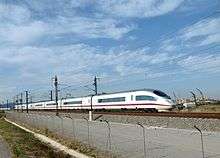
Barcelona is well-connected to the Spanish railway network, and to the rest of Europe. High-speed trains run frequently from Sants station (in the southwest of the city) to Madrid, Seville and Malaga. There are also regular long-distance connections that partially use high-speed infrastructure to all major Spanish cities.
Barcelona Sants is the main station. The historic Estació de França now mostly serves regional trains.
Direct regular high-speed train service goes to destinations in France. In addition to two daily TGV services from Paris (travel time ~7 hr to Barcelona), there is a daily service from Toulouse (3 hr), a daily service from Lyon (5 hr), and a daily service from Marseille (4 hr). Prices start at €39, so even though the train could take longer than a flight, it is often a cheaper and more relaxed alternative.
The former Talgo trains from Montpellier to Barcelona and Cartagena via Portbou ceased to run when direct high speed services started. It is still possible to travel via Cerbère/Portbou using local trains, but it's cumbersome, painfully slow and timetable coordination at the border is awful; however it may be the only alternative if all TGVs are fully booked. Also, if booked in advance, TGV can be way cheaper than using these local trains.
There is also a less-known rail line over the Pyrenees to Toulouse. There is roughly one train every 3 hours on the Spanish side and one every two or four on the French side, including an sleeper train from Paris (with a branch to Portbou which splits at Toulouse: check all timetables to see whether route is faster, it greatly depends on waiting times at the border). Purchasing tickets for this route can be tricky. The Spanish line is considered a commuter line despite being far away from Barcelona and does not appear in any global European timetable, so it is impossible to get an international CIV ticket, every portion must be purchased separately. Also, for southbound travel, the Latour-de-Carol station only sells SNCF tickets so the Spanish portion must be bought directly at the ticket inspector, cash only. The journey takes 7–8 hours (including transfer) and costs roughly €30.
The launch of the high-speed service spelled the end of the overnight sleeper-car service called Trenhotel between Barcelona and Paris. Trenhotels still do, however, run between Barcelona and Granada, A Coruña and Vigo.
.jpg)
By boat
The city's port is one of the busiest on the Mediterranean.
Large cruise ships dock 1-2 km to the southwest. Many of them offer bus-shuttles to locations at the south end of La Rambla. The ferries dock almost directly on the Ramblas.
There are regular ferry connections with the Balearic Islands (Alcúdia, Ciutadella de Menorca, Ibiza City, Sant Antoni de Portmany, Mahón, Palma de Mallorca), Italy (Savona, Genoa, Livorno, Porto Torres and Civitavecchia for Rome) and Tangier, in Morocco. From Rome (Civitavecchia) it is actually cheaper to take the ferry than a bus.
Some of the largest shipping companies includes Baleària, Grimaldi Lines and Trasmediterranea but there are several smaller companies as well.
By bus
All bus connections are at Barcelona Nord station (phone: +34 902 260 606). This includes national (e.g. 18 buses per day from Madrid) and international routes.
Megabus runs coach services between Barcelona Estacion del Norte and London Victoria Coach Station, via Paris and Toulouse. They also connect to Amsterdam, Cologne, Brussels and many UK cities. They can be very cheap, but be prepared for a 24-26 hour coach ride from London! There is a £0.50 booking fee. There may or may not be plug sockets or Wi-Fi on board. Megabus recommend that you be at your departure point at least 30 minutes before departure time (except London Victoria where you are required to arrive 60 minutes before departure).
By car
Several main roads connect Barcelona to France and to the rest of Spain. Traffic is usually relatively light outside of peak hours. Free parking spaces can be found a few metro stops from the center of the city.
Blue parking spaces are paid M-Sa 09:00-14:00 and 16:00-20:00. At some crossroads, the pay time starts at 08:00. Anyone can use a blue space, but they aren't that easy to find. You pay at the meter and put the ticket on the dashboard. Green parking spaces are for residents only. White parking spaces are free at all times, but there aren't any in the city centre.
City car parks are found throughout the city.
Get around
By public transport
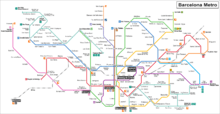
The public transport in the city and the surrounding area managed by Autoritat del Transport Metropolità (ATM) consortium. The whole area is covered by the Integrated Fare System, which is divided into 6 zones. This system includes the most of the public transport in the area: metro, city and intercity bus, tram and commuter trains.
The city limits of Barcelona are completely inside zone 1. The public transport in the city is mostly managed by Transports Metropolitans de Barcelona (TMB). They have a separate site dedicated for tourists. The other two operators in Barcelona are Rodalies de Catalunya and Ferrocarrils de la Generalitat de Catalunya (FGC).
Tickets and travel cards available:
- Single ticket. A non-integrated ticket is valid only for single mode of transport of a specific operator: either bus, metro or funicular, etc. €2.20.
- Hola BCN! cards by TMB. For unlimited number of journeys for 2, 3, 4 or 5 days. They are valid for TMB metro and bus, tram, FGC and regional trains in the city and metropolitan area. You will find the T-10 and its sister cards better value. 2-day card €14.50.
- Integrated for a fixed number of journeys. T-10, T-50/30, T-70/30. These cards are multi-person for 10, 50 or 70 single journeys respectively. During each journey it's possible to make up to three transfers. The whole duration of a journey must be no more than 1hr 15min and within zone 1. The T-10 is the best option for common tourists to the city. It's more convenient than buying single tickets. It's better value than the single tickets for more than 5 trips. It's far cheaper than the various discount cards with free transportation option. And finally, it doesn't bind one to specific routes like the hop-on-hop-off buses. T-10 for Zone 1 €10.20.
- Integrated for an unlimited number of journeys for a number of days. T-Dia (1 day), T-Mes (30 days), T-Trimestre (90 days). These cards are non-transferable, i.e. they must be used by a single person. T-Dia for Zone 1 €8,40.
Travel cards are excellent value in comparison with a single ticket. Be sure to look after them well as bent or damaged cards will not be read by the ticket machines. Such cards can be replaced at one of TMB's customer service centres.
TMB also offers a few route planners on their website: versions for desktop, for mobile browser and mobile apps for Android and iPhone. Another route planner is available on the ATM site.
By Metro
The Metro (subway) is an efficient way of getting around town. Operation times are 05:00–24:00 (M–Th), 05:00–02:00 (F), and continuous service from Saturday at 05:00 until Sunday at midnight. Stations are marked <M> on most maps; every station has a detailed map of exits to the city. Trains are fast, often coming in two minute intervals. However, on holidays and weekends trains only run every 6-8 minutes and can get easily packed. Announcements are made only in Catalan, though signs and ticketing machines are generally trilingual in Catalan, Spanish and English.
.svg.png)
Pay attention to the fact that to get from metro lines operated by TMB (1, 2, 3, 4, 5, 9/10 and 11) to the ones operated by FGC (6, 7 and 8), or vice versa, you need to exit and then enter through a new pay-gate. In this case, if you had a one-journey ticket, you need to get a new one. If you used a multiple journey ticket you won't be charged for a second time when changing lines as long as you are within the stated travel time for a single journey. Also, you can't repeat operator, so you can't use a FGC ride to make a shortcut. For instance: changing to L9S to L1 via L8 using Fira and Espanya will charge you with two journeys, you should go via Torrassa instead although its way longer. All trains are air-conditioned.
Take also care when travelling to the airport: while the T-10 is valid for Renfe services, it is not accepted at Metro. If you get to the airport by metro using a T-10, you'll be forced to pay the full fare, which is €4.50, and the ticket you've used will not be refunded.
By bus
The bus network in Barcelona is pretty extensive. Perhaps the best option in planning your route is to consult with one of the route planners mentioned above.
A major reorganisation of bus lines was completed in November 2018, so disregard old bus schedules and recheck routes. For example, bus line 92 to Park Güell, used by many tourists to get there after a visit to the Sagrada Familia, has been suspended, and a new line V15 stops there but takes a different route through the city centre (Passeig de Sant Joan).
Here are some tips for bus line codes:
- Hxx lines run parallel to the coastline, low numbers run on the high side, high numbers on the sea side.
- Vxx lines run from the beach to the hills, high numbers on the northern side (Besòs), low numbers on the southern (Llobregat).
- Dxx lines run in a somewhat diagonal path, although interestingly none of these cover neither Diagonal or Meridiana avenues, the main oblique streets.
- Mxx lines are found at the outer perimeter of metro coverage and link a metro stop to a neighbourhood lacking metro service.
- Bxx lines run on the northern area outside Barcelona or linking Barcelona to neighbouring municipalities in the metropolitan area, B stands for Besòs river.
- Lxx lines run on the southern area alike Bxx lines, L stands for Llobregat river.
- Some municipalities have lines fully inside the town limits with two letters and a digit, theses two letters are reminiscent of the town name. Examples: BDx for Badalona, LHx for L'Hospitalet...
- Nxx lines run only at night when all other lines do not run, roughly from 23:00 to 6:00.
- Cxx lines link Barcelona tho various northern coastal Maresme towns up to Mataró.
- Exx lines are express buses from / to Barcelona to various municipalities from 10 to 60 km outside of the metropolitan area.
- Lines with one or two digits without any letter follow historical routes from before the H-V-D schema.
- Lines between 100 and 199 are usually very local lines served with low-capacity cars and poor frequency, 30' or worse. Notable cases are line 111 to the Tibidabo amusement park, line 120 through Ciutat Vella, and line 150 to Olympic venues and the Montjuïc castle; others are mostly useless for tourists.
- Line numbers from 200 upwards are used for some routes going outside the metropolitan area, while some others of the same kind have no number at all.
Buses H-V-D run about every 6-12' minutes weekdays, 15-20' weekends. N buses run every 20' all nights. Other lines may run as frequent as 5' or as few as just one service per hour or less.
Take note that some lines have special fare restrictions: Barcelona cards (unlimited travel for 2 to 5 days) are valid only on Hxx, Vxx, Dxx and line numbers below 200. Any fare 1 travelcard is not valid for Cxx, Exx and line numbers above 200 - in fact, trips fully inside fare zone 1 are not permitted on these lines no matter which ticket is used, if you board any of these buses inside fare zone 1 you won't be able to get off until reaching another fare zone.
By scooter
- Mattia46, 50cc 125cc 150cc 200cc scooters for rent.
- GoCar is a two-seater, 3 wheeled vehicle that runs with a 49cc size scooter engine. It is legally classified as a scooter to drive on the roads. The GoCars were created with the purpose of being rented to tourists as a different way to see a city.
- Scooters for singles or couples are a great way to explore Barcelona at their own speed. If you are coming as a group you can get a personal tour of all the places you want to see.
- Cooltra Motos Scooter rental. You can rent a moped for 1, 2, 3 days and up to 1 month. You can also take a part in private or group tours.
- BookYourMoto Scooter and motorcycle rental in Barcelona. Cheap motorbike hire in Barcelona.
By bicycle
- Donkey Republic Bike Rental Barcelona. The orange Donkey Republic bikes are placed all around the city. Tourists can rent and unlock the bikes via the Donkey Republic app 24 hours a day. The app works to lock and unlock the bike without internet connection and bikes start at €12 per day.
- Born Bike Tours Barcelona. Takes you to the heart of Barcelona's culture through these Bike tours: The Gothic to Modernism Bike Tour, Beach Bike Tour, Montjuïc Bike Tour (from €24), Tapas Bike Tour (from €32). Also offers bike rentals from €6. Close to Métro station "Barceloneta" (L4), Marquesa nº1, +34 93 319 00 20. Email: info@bornbikebarcelona.com
- Barceloneta Bikes. Close to the harbor and the beaches, this company has different kinds of bikes you can choose to rent.
- Biking in Barcelona. Backed by Biciclot, a cooperative that promotes the use of bicycles in Barcelona.
- Budget Bikes. Quality Dutch bicycles on hire. Offers group reductions.
- e-bikerent. Electric bike rental from €7-20 per day.
- Mattia46 bikes & motos hire. Bikes and motors, 1 day (24 hr) on bike for €6.
- Terra Diversions. Big selection of city bikes, mountain bikes, hybrid bikes, road bikes and children bikes in different sizes.
Barcelona also has its own shared bike system, called BiCiNg. However, this appears to be only accessible for locals.
By segway
- Barcelona Segway Day, Rull 2 08002, ☎ +34 608 408 112. Visit Barrio Gotic and Barceloneta. from €29.
On foot
Barcelona is a very walkable city. It takes little over an hour to walk from Port Vell at the seaside to Park Güell at the foothills of the mountain range at the northeastern end of the city, and you can see a range of attractions, including La Rambla and Sagrada Família, on your way. There are opportunities all around to sit down and enjoy a drink or a meal everywhere. If you are fit, you can pretty much explore the city by foot alone, unless the heat beats you in the warmer months (and then you can always resort to the air-conditioned metro).
By car
Parking around all major tourist destinations is expensive (€3/hour, €20-36/day) and the spaces are difficult to navigate, as there are several classes of public parking spaces, with complicated rules for each class. Barcelona is plagued with the same problems that plague other major European cities; massive traffic jams and extremely narrow streets in some areas, coupled with a very complicated road system. As such, driving yourself around is not recommended for tourists, especially those with no driving experience in large cities. Public transport will get you to all the major areas, and you should use that as your main mode of transport.
Having a driving map is essential - plan your route before you set off. Navigating with an average tourist map is frequently misleading: many streets are one-way; left turns are more rare than rights (and are unpredictable). As an example, Gran via de Les Corts Catalanes is actually a one-way northbound street between Espanya and Marina, the opposite direction is reserved for buses and taxis only.
Some free parking spots reported by travelers are:
- Near Moll de Sant Bertran (which is south-west from Museu Maritim) - driving at B-10, exit to WTC and make a complete round at roundabout, heading to warehouses - and park next to its employees cars.
- Somewhere near Guell Park.
- Near Font Màgica, in Plaça Espanya.
Getting around by car makes sense if you plan to spend much more time driving outside the city borders than inside it - and ideally if you don't plan to park overnight at all. Otherwise, for purely in-city transportation, consider renting a scooter, or using public transportation instead.
By taxi
As of January 2019, ride-sharing services such as Uber require at least one hour's notice. For less than one hour's notice, you need to call a regular taxi.
Talk
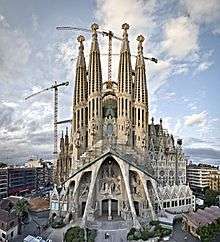
- See also: Catalan phrasebook, Spanish phrasebook
Barcelona's official languages are Catalan and Spanish. About a half prefer to speak Catalan, a vast majority understands it, and virtually everyone knows Spanish. However, most signs are indicated only in Catalan because it is established by law as the first official language. Yet, Spanish is also widely used in public transport and other facilities. Regular announcements in the Metro are made only in Catalan, but unplanned disruptions are announced by an automated system in a wide variety of languages including English, French, Arabic and Japanese. On the other hand, FGC announcements -either regular or disruptions- will be made only in Catalan, and disruption announcements on RENFE's network will usually be broadcasted only in Spanish. As in most other cities, any attempt by visitors to use the native languages is always appreciated. Most locals are bilingual in Catalan and Spanish, and instinctively address foreigners in Spanish. Catalan is a language, not a dialect, and sounds closer to Italian, Portuguese, and French in many ways. Avoid referring to Catalan as a dialect, which will offend Catalans.
You might find some locals answer in Catalan after being asked in Spanish, that's not because they are being rude but because they assume you are bilingual, in Catalonia it's not weird to see people speaking different languages in the same conversation. In case you can't understand what they are saying, tell them you don't speak Catalan and ask them to repeat it in Spanish or English.
The main cause of Spanish and Catalan social bilingualism in modern Catalonia is a large scale immigration process from the rest of Spain which occurred over the 20th century, as Catalonia started a significant industrialization which demanded an increased workforce from elsewhere. Nowadays, 60% of the people in Catalonia use Spanish as their first language whereas 40% use Catalan. The issues regarding language, national identity, and politics are like politics anywhere, and there's no way to summarize them here. Some Catalans feel Spanish and some don't.
In tourist areas, almost all shops and bars have some English speaking staff. People will generally make an effort to try to help you if you speak English. If you are a native English speaker you will not have any problems as Barcelona gets lots of tourists.
See
|
What to see in the dark The most spectacular sights in the night are:
|

The old city
Walk around the winding streets and hidden squares, fountains and palaces in the Barri Gòtic (Ciutat Vella). Highlights include the Catedral, the Museu d'Història de Barcelona (formerly known as the Museu d'Història de la Ciutat), and Plaça Reial.
Modernist architecture
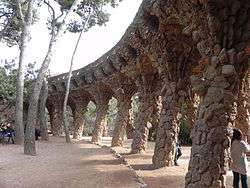
Since 1984 seven buildings by the architect Antoni Gaudí (1852–1926) in or near Barcelona have been listed as "Works of Antoni Gaudí" on the UNESCO World Heritage List: the basilica of Sagrada Família, Casa Milà (La Pedrera) and Casa Batlló in Eixample, Palau Güell in Ciutat Vella, Parc Güell and Casa Vicens in Gràcia, the crypt of the Church in Colònia Güell.
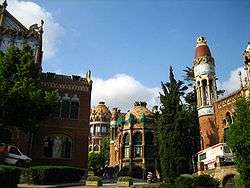
The works by the Catalan art nouveau architect Lluís Domènech i Montaner listed on the UNESCO World Heritage List: Palau de la Música Catalana in Ciutat Vella and Hospital de Sant Pau in Eixample.
The Ruta del Modernisme run by Modernisme Centre (Pl. de Catalunya, 17, subterráneo; phone +34 933 177 652): guidebook and discount voucher book for €12. Takes you round all the best Modernisme (art nouveau) buildings in Barcelona. The main part of the route can be walked in a couple of hours, providing you don't stray too far from the main routes. The Tourist Offices offer a pack that includes discounted tickets to many attractions such as La Pedrera and La Casa Batlló. All can be seen from the outside for free.
With children
- Museum of Natural History in the Forum - Museu Blau
- CosmoCaixa: Museum of Science Amazing museum for kids from 4-5 upwards. Adults will really enjoy it also.
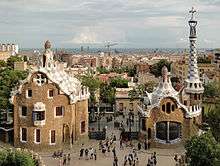
Do
- Barcelona Bus Turístic. This bus has three routes (map provided as you board), including a northbound and a southbound line that leave from opposite sides of the Plaça de Catalunya. Each takes 1–2 hours. The hop-on/hop-off format lets you get-off at any interesting stop, see what interests you, then get back on any later bus at that or any other stop. One approach is stay on for an entire route, then continue while getting off at locations that interested you earlier. Buses are double-decked, with the open-air upper deck offering much better views... sunscreen is essential in summer months, jackets in winter/early spring/late fall. Earphones are offered when you first get on so you can hear the commentary as you drive by significant locations. Outlets near every seat let you choose among many languages and playback volumes. The buses are very frequent. For a cheaper option with more flexibility in routes opt for the metro and the T-10. 1 day ticket €27, 2 days €38; tickets can be bought at the bus stops, some hotels, etc. or online with 10% discount.
- 🌍 Aeri del Port de Barcelona (Telefèric del Port), C/ Taquígrafo Garriga, 97 – Esc.B -2º9ª, ☎ +34 934 304 716, e-mail: tebarsa@hotmail.com. Jun-Aug 11:00-20:00; Mar-May, Sep-Oct 11:00-19:00; Nov-Feb 11:00-17:30. Have a ride at Port Vell Aerial Tramway. Port Vell Aerial Tramway is the 1450-metre-long harbour aerial tramway with red cars connects Montjuic and Barceloneta. It starts in Barceloneta on the top of the 78-metre-tall Torre San Sebastian tower, which has also a restaurant at its top accessible by an elevator. It has an intermediate stop at Torre Jaume I tower (close to Columbus monument), which can be reached by elevator from ground—107 metre tall tower, the second-tallest aerial tramway support tower in the world. The final point of the line is Miramar at the slopes of Montjuic hill. Overall, the whole system is quite old (built in 1929, albeit restored a couple of times), and the car is packed with tourists during the daytime — particularly sensitive for a stroller or a wheelchair. But if you start from the Montjuic side, there are fewer people waiting. single €11, return €16.50; it's not a part of Barcelona's integrated fare network.
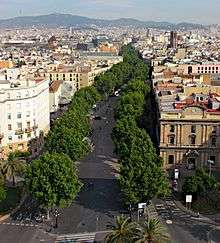
- Stroll along the following famous streets in Ciutat Vella:
- Las Ramblas or La Rambla, a gorgeous tree-lined pedestrian walkway, the busiest and most lively street of the city. Mostly occupied by tourists, expect to pay higher prices for food and drink. Avoid the groups of people supposedly betting on a game played on a cardboard table, they are thieves. Head off into some of the side streets for a cheaper, more local, and authentic experience of Barcelona. Often called Las Ramblas, because it is a series of several different streets each called 'Rambla de ____', the sections also have distinct feels. As you get closer to Plaça Catalunya, you find more street performers doing stunts. In the middle, you'll find street performers in costumes. Towards the pier, there are artists who will do pencil drawings, paintings, etc.
- La Plaça Catalunya. Connecting all the major streets in the city, the Plaça is known for its fountains and statues, and the central location to everything in the city. A favourite meeting spot for locals.
- El Portal de l'Àngel. Large pedestrian walkway with many new and stylish shops to browse in.
- Watch football ie soccer. The big team, globally famous, is FC Barcelona in La Liga, the top tier of Spanish football. They play at Camp Nou, capacity 98,000, 1 km west of Sants the main railway station. Nearest Metro is Palau Reial. Also in La Liga is RCD Espanyol: they play at RCDE Stadium, capacity 40,500, at the western edge of the city. No metro, take bus towards Ave del Baix Llobregat.
- Cruise miles of beachfront boardwalk starting from Barceloneta or get a tan on the beach.
- Sit on a wooden bridge to Maremagnum in Ciutat Vella and cool your toes at the water's edge: with a book, sandwich or just for a short rest.
- Wander the Barri Gotic in Ciutat Vella, the largely intact medieval center of the city.
- Enjoy your Sangria at La Plaça Reial in Ciutat Vella, near the La Rambla Street. Great place to sit,relax and drink. While visiting La Placa Reial
- Walk in Born in Ciutat Vella, a very popular area with great restaurants and places to have a few drinks. If your accommodation is on Rambla, Born is a great place to escape the crowds, enjoy a relaxed atmosphere and meet off-the-beaten track travelers and non-tourist-industry locals—especially in the evenings. El Born means jousting-field and its history and stories can fit one of those huge books stored in old libraries, there are interesting and quirky details to uncover while walking around such as the name given to its streets, the medieval signs to brothels and remnants of the secession war by the end of the 18th century.
- Visit a Flamenco Show in a real tablao. One of the best is Tablao de Carmen in Sants-Montjuïc. A cheaper alternative is in the jazzclub Jazz Si in Ciutat Vella.
- Ride the Cable Way to get from the sea front to Montjuïc mountain in Sants-Montjuïc
- Sit and sip on a coffee in Plaça dels Àngels in Ciutat Vella, while admiring the whiteness of the MACBA and the best street skate tricks in town.
- Catch a performance at the beautiful Teatre del Liceu or the Palau de la Musica Catalana both in Ciutat Vella.
- Rent a bike or join a bike tour and get to see the highlights of the city in a different way. Ride from the magic beaches of the Mediterranean, to Gaudí's modernist buildings through the medieval atmosphere of the Gothic Quarter.
- Sail 3 hours to see Barcelona from the sea.
- Mail boats serve almost all populated in Barcelona, and are among the cheapest way to reach many areas, though far from the fastest or most comfortable. The government has a mailboat schedule of mailboat routes online which may or may not reflect reality.
- Sail on a classic yacht. Enjoy a day trip sailing along the Barcelona coastline on a classic yacht.
Festivals and events

Barcelona hosts a number of annual fiestas, many of which are unique to Catalonia and offer an insight into its distinctive culture.
- Sónar. An annual three-day music festival. It is described officially as a festival of Advanced Music and Multimedia Art. Music is by far the main aspect of the festival. The festival runs for three days and nights, usually starting on a Thursday in the third week of June. There is a day and separate night location. €52 daypass, €76 night entry, €199 festival pass on internet booking, higher fees for entrance passes.
- Monegros Desert Festival. The most famous and biggest one day/night electronic music festivals in Spain is in desert of Fraga 200 km from Barcelona. More than 40 000 people gather every July to celebrate the electronic music with the best DJs representing styles from house, electro, minimal, techno, to drum&bass, dubstep and hiphop. 20 hours nonstop, unique desert experience.
- Festes de la Mercè. Barcelona's main annual festival around 24 September, encompassing many events such as which group of 'castellers' can form the highest human tower, live music events, firework displays and processions involving wooden giants. All of this is accompanied by a heavy consumption of Cava, the national drink of Catalonia.
- Festes de Gràcia. The Festes de Gracia is a Catalonian celebration, held around 15 August each year to commemorate the Assumption. During the week of festivities that mark one of Barcelona's most important fiestas, the city of Gracia explodes with fun, excitement, color and fireworks. Many streets are decorated by the neighbours, live music, food in the street, and the parties continue all night.
- Festes de Sants. Similar to Gracia's event, but smaller and later on in August. If you can't go to the Gracia's, try to go to this festival instead.
- Sant Jordi. 23 April. Considered to be like Valentine's Day. People give roses and books around the streets. Traditionally men give women roses and women give men books. It is one of the most popular and interesting celebrations in Catalonia.
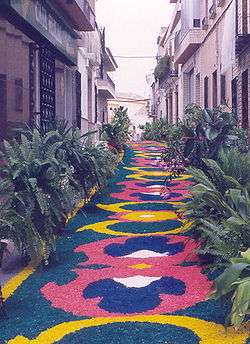
- Corpus. Late in May (Corpus Christi day). An egg is put over the fountains (most of them in the churches, and decorated with flowers), and "magically dances" over the water. Most of the churches are in the city center: Cathedral's cloister, Santa Anna, Casa de l'Ardiaca, Museu Frederic Marés, and over 10 more fountains.
- Fira de Santa Llúcia. From 2/3 December to 23 December, to commemorate Sta. Llúcia (13 December). During this time, in front of the Cathedral, Christmas objects are sold. Some places sell Christmas trees, but most of them sell elements for making the pessebres (Nativity scenes). These include small sculptures, wooden pieces and moss used to simulate grass.
- 13 December is the feast day of Santa Llucia, patron saint of fashion designers and blind people, who gather at the Santa Llucia chapel in the cathedral to pay their respects.
- Barcelona Jazz Festival. A brighter way to celebrate the colder Autumn days, the annual Jazz festival has been running for nearly 50 years now and runs roughly from the last week in October and all the way through November Tickets prices differ for each event.
- Revetlla de Sant Joan. This is the midsummer solstice celebration. It is celebrated on 23 June every year and is signified by the fireworks (there are frequent and loud amateur fireworks all night long, which may make it hard to sleep) that are permanently on display during this time.
- Fira de Barcelona. There are trade events all year round in Barcelona.
- La Mercè (a few days before 24 Sept): Another day that is famous, but not that important. It is a holiday and the city offers a lot of activities to have fun. Enjoy a fountains and fireworks show at the base of the Montjuic hill.
During festivals and especially during Mobile World Congress which is a major trade show at the Fira, accommodation in Barcelona and especially near the Fira is much more difficult to find and more expensive than usual.
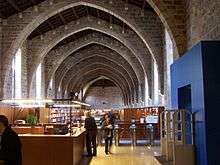
Learn
For those wishing to make a real attempt at learning the language, there are plenty of Catalan and Spanish language schools in Barcelona.
- University of Barcelona. Tel: +34 934 035 478
- Universitat Autònoma de Barcelona Tel: +34 93 581 13 25
- Pompeu Fabra University Tel: +34 93 542 14 17
- Universitat Ramon Llull Tel: +34 93 602 22 00
- ESADE Business School
- Don Quijote You can take 4–6 hours of courses a day. All courses including beginner courses are taught entirely in Spanish.
- Linguaschools Barcelona organizes Spanish courses for foreigners. The school is open all year round. 5 min. from Plaza Catalunya.
- Olé Languages Barcelona. Av Mistral 14-16 Local 6, Tel: +34 93 185 15 18
- Versión Original Barcelona. Gran Vía / Passeig de Gracia, Tel: +34 93 412 45 76

Buy
Most shops and shopping malls are closed on Sundays because of law restrictions. In Ciutat Vella you will find plenty of small fashion shops, souvenir shops and small supermakets open on Sundays. The souvenir shopping scattered throughout the Barri Gotic and all along La Rambla are tourist traps, none of them sell Catalan or Spanish products but the typical array of Chinese general souvenirs, they should be avoided. Moreover on the Port Vell, right at the end of The Ramblas there is Maremagnum, a shopping mall that stays open all Sundays.
- Secondhand English books in Gràcia.
- Design lovers head for Gràcia.
- El Corte Inglés. Spanning several floors and several buildings, and in several locations around town, many in Eixample and Inland Suburbs and a couple also in Ciutat Vella. You can find anything and everything in this department store, from gastronomy to pneumatics. Tax return checks are made on a separate floor of the store. See review for the whole chain in the Spain article.
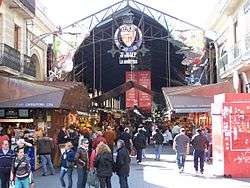
- 🌍 La Boqueria (Mercat Sant Josep). In Ciutat Vella. Large public market with a diverse range of goods and produce. Enjoy freshly squeezed organic fruit juices for €1.5 per cup. If you go near closing time (20:00) sellers will make you a special price (2 or 3 for €2). Closed Sundays.
- Stamps are actually sold in 'Tabacs' or tobacconists. Once you know what they look like, you'll notice them on every block or so. To post your mail, you need to find one of the rare yellow letter boxes along the sidewalks.
- Records For vinyl records, try the wonderful shop Discos Revolver at 13 Carrer dels Tallers.
- Supermarkets are spread across the city. Mercadona, Consum, and Dia are all supermarket chains from Spain and are a cost-effective way to purchase grocery items. There are also organic/specialty supermarkets like Casa Ametller or Veritas which are pricier. Small corner stores are the most visible on city streets, but tend to mark up prices in exchange for convenience.
Eat
As with all cities which welcome large numbers of tourists, Barcelona's cuisine is inconsistent in quality, but there are plenty of restaurants serving excellent food at very reasonable prices, if you know where to look. The usual rules of thumb apply: to save money and get better food, look for places off the beaten track used by fellow travellers, and seek out cafés and restaurants which the locals frequent. In practice, this usually involves searching out eateries in residential districts away from the main sightseeing attractions. Avoid restaurants with touts outside, and have a basic understanding of the traditional foods served in restaurants, as well as the local drinks. One slightly crafty way of sussing a place's authenticity at a glance is to take note of how they spell a certain word: a menu board advertising tapas, written the Spanish/international way, is likely to be somewhere which primarily caters to tourists, whereas somewhere offering tapes, using Catalan spelling, is in all probability a venue frequented by locals.
Some districts to check out include Gràcia, which is a hub of quality, affordable Catalan cooking of both the traditional and more avant-garde varieties, and the Eixample, whose chic boulevards have upscale restaurants aplenty worthy of your splurge money. The fishing quarter of Barceloneta (in Ciutat Vella) is an example of a neighbourhood where it pays to be picky: closer to the gentrified seafront, a slew of mojito beach bar-style places serve up expensive tourist tapas; for the real thing, head into the backstreets, where many traditional bars are still tucked away. In all cases, be prepared to "promenade" in search of the most attractive-looking menu; that's what the locals do, after all.
|
Where to eat during siesta The majority of restaurants and cafes are closed 16:00-20:00 for migdiada. If you failed to plan for that, here are some places you can eat during this period:
|
Set menus (menú del migdia) Most restaurants (and some bars) offer a menú del migdia (menu of the day), which usually means a simple and unpretentious two course meal (one salad, main dish and a drink; plus a dessert sometimes), 3 or 4 options each, with a drink and a dessert, for €8 to €20, depending on the restaurant. Depending on the restaurant, the portions may be quite generous, or rather small. During the week, some smart restaurants offer lunch specials from 14:00 to 16:00. The savvy traveller will try the hip places for a fraction of the price during the day.
If you're looking for a place where everyone can choose their own meal, ask for restaurants that serve platos combinados, which is the closest thing to an American/Northern European meal.
Smoking is not permitted in restaurants anymore.
Dishes
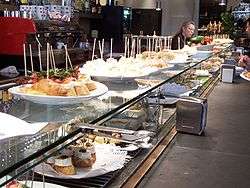
You can get food from any part of the world in Barcelona, but make sure you try some Catalan food.
See Catalan cuisine section in the Catalonia article.
The selection of seafood is consistently great, although not a lot of it is local (this part of the Mediterranean is pretty well fished-out).
A treat to try that no travel guide mentions is waffles sold at street stands. They will tempt you with their mouth watering smell and taste.
Tapas restaurants are now all over the city (although tapas originated in Andalusia in the south of Spain). Each Spanish region has its native tapas; signature 'Catalonia' tapas is delicious. Some Catalans eat a more French-style three course meal (appetizer, main dish and dessert) and would more likely go for a pre-meal beer/vermouth and some snacks (olives, chips, etc.); others go for a meal entirely of tapas. This pre-meal snack is called 'fer el vermut' or 'making the vermouth'. As you travel to smaller towns in Catalonia outside of Barcelona, it is less likely that you will find tapas and more likely you'll see restaurants serving traditional Catalan food in three courses.
Beyond Catalan food, there is no shortage of durum or shawarma stands in Barcelona, offering tasty beef or chicken and salad in toasted flatbread for around €3.50. Gyros are delicious! You can also consider the Asian selection, with a lot of Chinese, Japanese and Indian restaurants. As with anywhere else, there are plenty of Italian restaurants, while Latin American offerings, particularly Argentine and Mexican, are well-represented too.
Food tours
If you feel lost in the variety of food choices there are - Catalan, Basque, Spanish, and beyond, it may be helpful to do a food tour to quickly get oriented. Many independent tour operators run food and wine tours in the city.
- Barcelona Eat Local Food Tours, Hurtado 28 Barcelona, 08022, ☎ +1 800 656 0713. A family-owned business that showcases the best of Catalan gastronomy in off-the-beaten districts of Barcelona.
- Foodie&Tours. A third-party website that has selected and listed best gastronomic tours in the city, including cooking classes, tapas walking tours, and vineyard visits. Bookings are possible through their website.
Areas to eat
Depending on where you are in the city, there may be restaurants galore, or none at all. The following areas tend to be restaurant "hubs", with a large variety of restaurants to choose from:
- Barceloneta: A popular quarter for locals, where you can try fish based dishes, such as Paella (a name that may hide many different kinds of rice concoctions) or Arròs negre (Black Rice), that takes its colour because it is made using squid ink. Barceloneta is a very good place to eat tapas as well.
- Sant Antoni is the new addition to the culinary scene in Barcelona where old and trendy cuisine mingle.
- Eixample Esquerra (between Gran Via and Mallorca)
- Barri Gòtic (especially for tapas)
- "El Born" (next to Barri Gòtic)
Around Plaça Catalunya there are dozens of restaurants serving tapas. One should be careful with the tourist traps as the area is highly populated with tourists.
For budget eating you may choose "menú del migdia" in small bars on the Avinguda del Parallel for €9-11 per person. Be aware that sometimes the menu and the staff are only in Spanish.
The large cafes that line the Passeig de Gràcia and the Rambla Catalunya, just north of the Plaça Catalunya, offer a variety of acceptable tapas. This part of the town is quite touristy and a bit expensive.
| This page uses the following price ranges for a typical meal for one, including soft drink: | |
| Budget | Up to €10 |
| Mid-range | €10 - €25 |
| Splurge | €25 and up |
Groceries
In several supermarkets you can find a wide stall with a great selection of ready-to-eat dishes. You can get a two-course lunch for less than €5.
Restaurants
- Individual listings can be found in Barcelona's district articles
- Comer y no Bombas (Location is variable). Shares free vegan food.
- Juice bars. More and more the city is being populated by bars that serve organic/vegan food and cold-pressed juices.
- El Glop. Three locations, in Eixample and Gràcia. Excellent mid-range Catalan meals. Allow about €20 per person, although you could get out of there for half of that if you let the price dictate your choice of dishes.
Drink
Cafes
Try a "café con hielo" an espresso served with a glass of ice cubes on the side and any local 'cafeteria'. Cafes are found on each corner in Barcelona, and these days a conscious movement in favour of top quality coffee is changing the scene in the Catalan capital with a new trend in terms of coffee houses.
Bars
- Chupitos are found in several locations throughout the city, including one in Barceloneta. Chupitos is Spanish for "shots" and offers hundreds of unique shots including the "Harry Potter" (a shot that sparks as cinnamon is sprinkled over it), and "Monica Lewinsky" (a variety of flaming shots) among others. As much a show as it is a place to get a drink, it's a fun night out.
Sleep
.jpg)
Barcelona offers a great range of accommodations, from cheap, decent apartments, hostels and guest-houses to five-star hotels. Every district has plenitful offerings, and thanks to the efficient public transportation you can stay comfortably in any of them, depending on your budget and preferences.
- Ciutat Vella offers a mix of luxury hotels and cheerful hostels within a dense urban environment. Staying there means being at the heart of Barcelona's nightlife - which is both lively and noisy.
- Eixample and Gràcia and Sants-Montjuïc are calmer, but quite as dense, and popular due to closeness to attractions. You will find more mid-market properties there.
- Sant Martí contains most of Barcelona's beaches and a string of very modern hotels along the Diagonal
- The suburbs are not as far away as you may think thanks to the metro and local railway. Some hillside hotels offer great views, but may be far away from public transit though.
See the district articles for detailed listings of accommodation opportunities.
Connect
Internet
- Barcelona WiFi. Daily 08:00-01:00. An internet service provided by the city council. There are more than 700 Wi-Fi hotspots in the city, mostly at various municipal buildings. The speed is limited to 256 Kbps, VoIP applications are filtered. No registration is required. Free.
Stay safe
Pickpockets
Barcelona is Europe's pickpocketing capital. Never keep your wallet, cash or important documents in trouser pockets or in bag pockets: a money belt is an easy and inexpensive way to prevent being robbed. As always, be alert in crowded places, such as public transport, train and bus stations, La Rambla and Raval. People may approach you asking for change, or to change money. Just ignore them. If you are asked to change money, then official looking police may approach you afterwards to 'check' your wallet for ID, etc. These are not police, so be at your most vigilant or you might find they have taken a few cards or cash upon returning your wallet. If you are in a crowd of spectators watching street entertainment, beware of anyone getting suspiciously close to you.
Pickpockets use the football trick as the local specialty. At certain tourist hotspots, there are people who will try to show you a 'magic trick'. This involves tying a piece of string around your finger. While you are distracted (and your arm is effectively disabled), an accomplice will pickpocket you. It is also possible that criminals will pose as tourists and ask directions to approach their victims. Keep your distance and be careful in tourist places.
The subway is a hotbed for pickpocketing activity, which can range from simple opportunistic thefts to coordinated attacks. Be especially wary on the subway platforms at Sants train station and Sagrada Família. A group of men will come out of seemingly nowhere while you attempt to enter a subway car and block your entrance and exit in a coordinated manner, effectively pinning you against the doors while they close. They will act as if the car is just crowded and they are trying to get on as well, but, in reality, they have already gone through your pockets.
Once they take stuff, they quickly return to the platform and walk off calmly while you are trapped in the departing subway as they make sure they exit just before the doors cannot be reopened. Violence in these situations is rare, and in most cases the goal of the thieves is to rob you undetected. Stay vigilant: do not leave anything in a back trouser pocket (except maybe a map of the city). Hold on to your bag or purse at all times. Do not leave anything unattended while you sit in a cafe or restaurant.
One guy acts like he's reading a newspaper and is about to go into the subway gate (he's scanning his target). While you insert your subway card to enter and before the gate opens, that guy immediately enters his subway card also, which causes the gate to jam and alarm sound. Immediately 3-4 other people appear and, while acting like trying to help, (pointing to the gate telling you 'the door is jam') will try to snatch your backpack or wallet while you are still surprised. Check and make sure no one tailgates on you, or, simply, just let the guy go first.
While you are at an outdoor table of a café, don't leave your smartphone on the table. Someone will try to steal it. For example, a guy babbling for change with an unreadable poster in his hands, getting closer and closer to the smartphone until he eventually picks it up, passes it to a second guy that will run away with it.
Scams
- See also: Common scams
People in Barcelona are often very friendly and love to practice their English, so don't be unfriendly. That said, you should, of course, be suspicious if someone approaches you in a touristy area speaking your language and asking you for help. This should put your guard up immediately. Do not be tempted to sign their petition, give them directions, or help them with their problem. You don't know anything about where you are, since you're a tourist, so you won't be able to help them in any case.
Professional scam artists exhibiting a high degree of coordination are active in many areas of the city. Be careful in tourist areas. A variety of methods are employed, including the No-change trick. A common scam involves fake cops who will show up ask to see your passport, then take your belongings at the first opportunity. The story varies, but they are almost certainly not real ones. When it happens, the best strategy is to just walk away instead of starting any sort of conversations with them. Another trick is that one seemingly confused person will ask you for directions, diverting your attention and then suddenly fake police will appear asking for your ID. This is a co-ordinated move to divert the attention and steal whatever is possible. If such incident happens, just walk away, without listening to any of their conversation. Stay alert, especially in busy tourist area near the Sants station and Plaça d'Espanya.
Another popular scam happens in the metro. A group of scammers (often middle-aged women) will take advantage of the fuss while people are entering the metro and surround a tourist, frantically asking for directions. Most tourists won't know what to say while one of the scammers empties their pockets. They will try to confuse the tourist while the metro stays in the platform, and will get out just before the doors are closed. When you realize you've been scammed, the train will have already left and they will be safely outside with your belongings.
The bird excrement scam is also common. One or more accomplices will secretly spray or throw a smelly liquid on you. When you look up thinking a passing bird has pooped on you, they will run up to you and tell you that they saw a bird poop on you. They will offer to help you clean up, and while you are cleaning they will go through your pockets and any bags you have set down. It is wise to beware of anyone who is attempting to touch a complete stranger.
A version of Three Card Monte is one of many common scams played on Les Rambles. There are also people holding petitions to install a wheelchair lift in locations with a lot of stairs. Once your signature is obtained they will then aggressively ask for a donation. Sometimes there can be crowds of children demanding money with hardly anyone else in the area, making it difficult to get away.
Football
Local club FC Barcelona is seen as a symbol of Catalan nationalism, and has a very heated and politically charged rivalry with Real Madrid, which is seen as a symbol of the Spanish state and ruling establishment, and violent confrontations between the supporters of both clubs have been known to occur. Avoid wearing Real Madrid jerseys while you're in Barcelona, especially on matchdays, as that could result in you being singled out for violence by local fans.
ATMs
Barcelona offers ATMs in many locations. Many provide a wide range of services (withdrawals, transfers, mobile credit recharges, ticketing, etc.), and most accept ATM/debit/credit cards of various banks. Choose an ATM in a secure or highly-public space (e.g., in a bank lobby or airport terminal) to avoid machines modified by criminals to skim/video your card data or where you might be robbed after use. Ensure early in usage that the ATM supports a language you understand. For a full discussion of safe/effective charge/debit/ATM card usage and their cost trade-offs, see Money.
Areas of caution
Be very careful in the Barcelona Sants train station where thieves prey on new arrivals, even on the platforms.
Women travelling alone should exercise caution while exploring the more isolated parts of Montjuïc. The city beaches, particularly the ones adjoining Barceloneta, have proven to be quite lucrative for bag snatchers. Anything that one would rather not lose is best left, locked, in one's hostel or hotel.
Men traveling alone should expect the prostitutes on Les Rambles, St. Antoni, and Raval in the early hours to be very aggressive and in league with pickpockets and robbers.
Also, people need to be careful when leaving the bars of the Olympic Port late as there are many pickpockets around.
Women should be wary of wearing exposed jewelry such as gold chains and necklaces. People walking down a street may be attacked from behind by a thief who may grab the necklace and try to rip it off the woman's neck before quickly running away, often down a convenient side street. Be especially careful of seedy looking men on bicycles as grab and snatch assaults can occur.
In the event of such a robbery, people will need to find the local police station to report the incident, especially if a travel insurance claim is going to be made. Don't expect any police action beyond the report though as these types of events are par for the course and arrests, even when made almost never lead to prosecution due to a slow, antiquated, and overburdened legal system.
Parts of Barcelona are covered by closed circuit TV surveillance, but only the more popular spots.
Anti-tourism movement
Many Barcelona residents have the impression that there are too many tourists in Barcelona and that it has increased living costs, as landlords prefer to rent to tourists and not to locals to make more profit. Also, a lot of local shops have closed to make way for souvenir spots, so many locals feel they are being expelled from areas they have lived their whole life. In some areas, particularly the ones next to the beach where drunken tourists often stroll in swimming suits, there have been anti-tourism demonstrations by locals, which have had the backing of the Mayor of Barcelona. It's not clear how this will evolve. If you find yourself near a demonstration against tourists, consider moving away from the area at least for several hours, to allow the situation to calm down.
Cars
Tourist drivers may attract special attention, such as Red light bag snatch or Flat tire scams
Public transportation
Besides being a particular pickpocket hot spot, there are plenty of fare evaders who will stick to you when crossing a fare barrier. Do not even attempt to block their way and let them pass, as many of them can be quite aggressive. Although stations are full of surveillance cameras, they are seldom used to either enforce fare payment or as a proof for filed assault charges, except in the most severe cases. Lack of staff in many stations and few ticket inspections effectively mean carte blanche for them. The fare evasion fine is just €50 if paid on spot, no matter how many times the culprit has previously been caught, and many fines remain unpaid because payment enforcement is legally way too cumbersome.
Reporting crimes
If you need to report a crime (for example, to claim on travel insurance), be prepared for the reality that in the downtown police station, officers generally do not speak English, even though the theft report form is in English, Spanish, and Catalan. The police station most often used to report theft is the one underneath Plaça Catalunya beside metro station, where they have some translators for common world languages.
Cope
Hospitals
EU citizens can get free or reduced cost medical treatment on presentation of an EHIC card and passport.
- Hospital Clinic I Provincial De Barcelona, C/ Villarroel 170 (Metro Stn Hospital Clinic (Line 5)), ☎ +34 932 275 400.
Consulates
|
Go next
Day trips from Barcelona include:
- Costa Brava - The coast North of Barcelona has rocky cliffs and a mix of pebble beaches and sandy beaches.
- Figueres- Home of the most impressive Salvador Dalí museum.
- Montserrat - Visit the monastery nestled high in the mountains to see the Black Madonna or hike to the peak to earn a fantastic view of the surroundings. 50 km from Barcelona.
- Colònia Güell — is a tiny settlement famous for its modernist architecture. It is on the railway to Montserrat.
- Sitges - A traditional beach side destination for the locals. Full of fashion shops open on Sundays. Is a popular gay destination too.
- Canet de Mar - Is small enough to walk almost anywhere. See the historical centre, the churches and cathedral, and visit many architectural works of Lluís Domènech i Montaner. Canet is the smallest town in Catalonia with many historical and modernist buildings. It also has a lot of blue flag beaches, recognised at the European level for their quality.
- Girona - A quiet town with an ancient Jewish section, narrow streets, imposing walls and plenty of cafes. See directions to the north airport above.
- Pyrenees - A mountain range around 150 km north from the city.
- Sant Cugat del Valles - Has one of the most interesting Romanesque cloisters in Catalunya, with many interesting carvings. The town itself is full of expensive vilas.
- Montseny - UNESCO Biosphere Reserve 40 km northeast of Barcelona. Go there by car or bus/train